Plants with big leaves will add a bold and tropical feel to any garden or indoor space. Are you looking to create an eye-catching centrepiece or simply want to add some plants to your decor?
Large leaf plants are a great choice. With a wide range of shapes, sizes, and textures to choose from, there is a plant perfect for you.
More...

Popular Plants with Big Leaves in Australia
Here are 20 different large leaf plants in Australia:
1. Giant Birds of Paradise (Strelitzia nicolai)

Giant birds of paradise plants are also known as Strelitzia nicolai. It is characterised by its large, banana-like leaves that can grow up to 3 metres tall. It has striking flowers that resemble the beak of a bird. The flowers are blue and white with purple bracts. However, the plant may take several years to bloom.
Giant birds of paradise plants can be grown indoors or outdoors. It does require bright light with some partial shade. It should be protected from direct sunlight. When grown outdoors, it needs to be protected from hard frosts.
Giant birds of paradise plants prefer rich, moist soil with good drainage. It can grow in most moist soils. Fertilising should be done in mid-spring, mid-summer, and early autumn.
Read our Strelitzia nicolai growing guide to learn more about this plant.
2. Fruit Salad Plant (Monstera deliciosa)
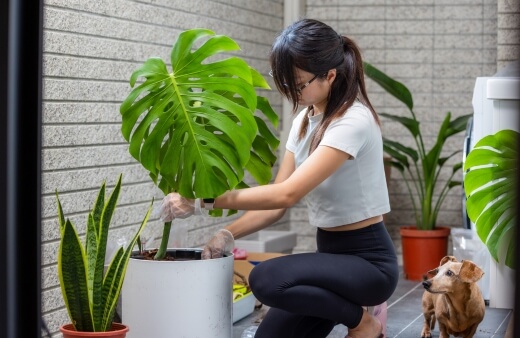
Fruit salad plants are also known as the split-leaf philodendron. They are tropical plants with big leaves. The leaves are heart shaped with distinctive holes and cuts. The leaves can grow up to 1 metre in length.
The plant itself can grow up to 10 metres tall in the right conditions. It produces an edible fruit that is said to taste like a combination of pineapple and banana, hence its common name "Fruit Salad Plant."
Fruit salad plants can be grown indoors and outdoors. If grown indoors, they need a trellis to grow on. Outdoors, the plant should be placed next to a structure it can climb such as a fence, tree, or house.
It needs bright light when grown indoors. Outdoors, it can grow in partial sun to dappled shade. The plants prefer well-draining soil and regular watering. Once established, it can tolerate some degree of drought.
Regular fertilising will result in lush, vigorous growth. Refer to our Monstera deliciosa growing guide for more info.
3. Elephant Ears (Colocasia esculenta)
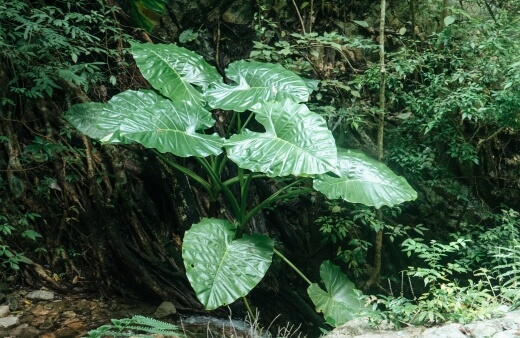
Elephant ears are also known as Taro. The plant gets its name from the large, heart-shaped leaves that resemble the ears of an elephant. Their foliage, which can vary in colour from green to purple, and can have distinctive veining patterns.
The plant can grow quite large, with leaves reaching up to 1 metre in length. Elephant ears thrive in warm and humid environments and are typically grown as outdoor plants. Elephant Ears perform best in sun to partial shade. The darker varieties do best in full sun.


Get Your Free Guide:
Master Growing Australian Natives eBook
A Must Have Complete Guide for Every Australian Garden
Get Your Free Guide:
Master Growing Australian Natives eBook
A Must Have Complete Guide for Every Australian Garden
They prefer well-draining soil and regular watering, but can also tolerate some degree of drought. Fertiliser should be applied every month in the spring, summer, and early fall.
Check out our comprehensive guide on different elephant's ear cultivars for more options.
4. Swiss Cheese Plant (Monstera adansonii)
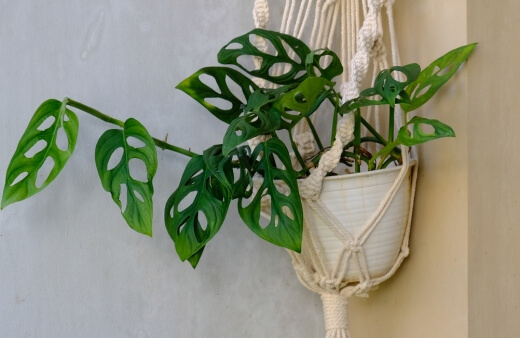
Introduced in 2016, the Swiss Cheese plant has rapidly gained popularity among plant enthusiasts. Its elongated stems and petite heart-shaped green leaves bear distinct perforations. These create unique hole patterns on each leaf.
Swiss Cheese plants can be grown indoors or outdoors in a shaded area. Light pruning is required from time to time to tame the plant and produce thicker vines. The plant can be allowed to cascade over the edges of a container or supported with a climbing structure.
Swiss Cheese hanging plants do not need direct sunlight. They should be planted in soil rich in organic matter. Apply a slow-release fertiliser every 6 weeks.
5. Tree Philodendron (Philodendron bipinnatifidum)

Philodendron selloum is known by many names, including Tree Philodendron. It is characterised by its large, deeply lobed leaves that can grow up to 1 metre in length. The leaves are glossy, green and often have a slightly wavy edge.
Philodendron selloum prefers bright, indirect light and well-draining soil. It can tolerate some degree of drought. It is important to avoid over-watering the plant, as they are prone to root rot.
The plants can be grown indoors or outdoors. When grown indoors, it is important to note they can grow up to 1.5 meters wide. Also, when grown indoors, they rarely flower. To prevent over-fertilisation, it is recommended to only feed the plant once a month during spring, summer, and fall.
6. Spoon lily (Alocasia brisbanensis)
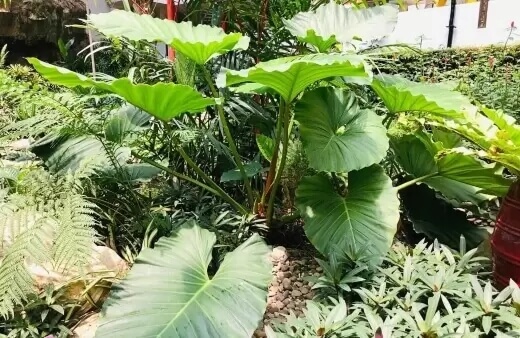
Alocasia brisbanensis is also known as the spoon lily. It has large, heart-shaped leaves that can grow up to 1 metre in length. The leaves are glossy and green. They have distinct patterns.
The plant produces thick, fleshy stems that support the big leaves. The spoon lily can grow up to 2.5 meters tall in perfect conditions. The spoon lily prefers bright, indirect light and well-draining soil and should be kept moist but not waterlogged.
This plant can be grown indoors or outdoors. When planted outdoors, the plant should be fertilised with liquid fertiliser twice a month in the spring and once a month in the summer. When grown indoors, feed once a year with liquid fertiliser.
Check out our Alocasia growing guide for more details and discover its beautiful varieties.
7. Split-Leaf Cyclanthus (Cyclanthus bipartitus)
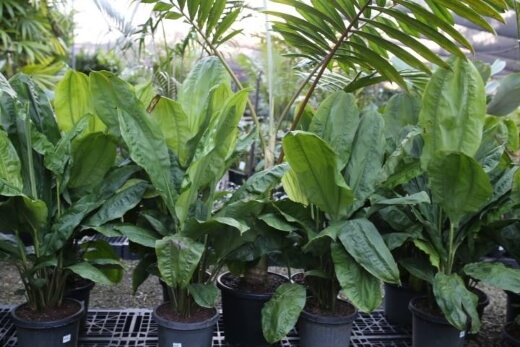
Source: Oxley Nursery
Cyclanthus bipartitus is also known as split-leaf cyclanthus. It is known for its unique, deeply split leaves that create a fan-like appearance. The leaves are a glossy, dark green colour. The plant's flowers are small and greenish white.
The Split-Leaf Cyclanthus plant can grow to be 3 metres high by 4.5 metres wide. This plant prefers a warm and humid environment with filtered light or partial shade. It can tolerate some direct sunlight, but too much can burn the leaves.
The Split-Leaf Cyclanthus plant is also sensitive to cold temperatures and should be protected from frost. This plant can be grown both indoors and outdoors. However, it is important to note that the plant can get very large.
Fertilising is not usually necessary. But regular monthly feedings with a liquid fertiliser will help produce strong growth.
8. Elegant Fan Palm (Licuala peltata var. sumawongii)

The elegant fan palm is also known as the licuala elegans. It has large, circular leaves that are deeply divided into segments. The palm can grow to be 3-5 metres tall by 2-3 metres wide.
This palm tree is best suited for warm, humid environments. It prefers partial sun to shade. It should be planted in rich, well-draining soil that is kept moist but not waterlogged. The elegant fan palm can survive short periods of drought once established.
The elegant fan palm grows best outdoors. However, it can be grown indoors in a bright area away from air-conditioning and heating. Fertilise regularly and remove spent fronds when needed.
Also read: Popular Fan Palms to Grow in Australia
9. Peace Lily (Spathiphyllum wallisii)
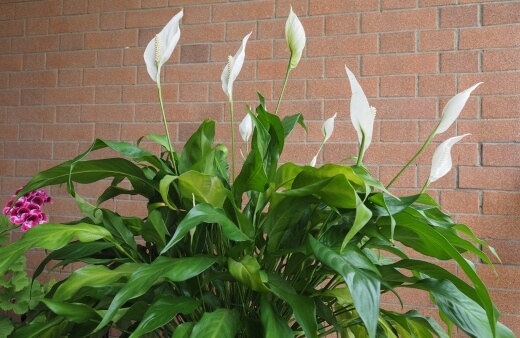
Spathiphyllum wallisii is also known as the peace lily. It has dark green leaves with bold white stripes and spots. It is eye-catching in appearance and popular among plant enthusiasts. It can grow to 40 cm high.
This indoor plant with big leaves grows in full shade and dappled sun. It prefers soil that is kept moist, but not waterlogged. If soil is left to dry out, the leaves will droop. Do not use water that has been treated with fluoride or chlorine.
Peace lilies grow best indoors in pots. Fertilise monthly with a liquid, lower nitrogen fertiliser for best colouring.
10. Cardboard Palm (Zamia furfuracea)

The cardboard palm is also known as the cardboard cycad. It features a thick trunk with fronds of rounded, stiff, leathery leaves. The plant can grow up to 100 cm tall.
The cardboard palm prefers full sun to partial shade. It should be planted in well-draining, sandy soil. Soil should be kept moist. However, once established, the plant can tolerate hot, dry conditions.
This is an outdoor plant with big leaves. If planted in a pot, the pot size should be extra-large to accommodate the long roots. The plant should be fertilised yearly with a slow-release fertiliser.
11. African Mask Plant (Alocasia x amazonica ‘Polly’)
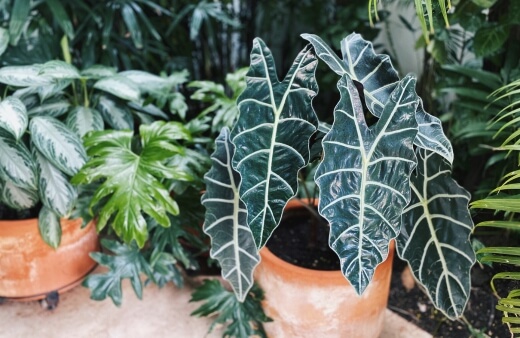
The African mask plant is also known as the Alocasia ‘Polly’. It is a stunning tropical plant with large, arrow-shaped leaves. The leaves can grow up to 91 cm long and 30 cm wide. The leaves are dark green with prominent veins. The plant can reach up to 60 cm in height and 60 cm in width.
African mask plants prefer bright, indirect sunlight. The plant should be planted in a combination of potting mix and sand. Only water the plant once the soil has dried out about 5-7.5 cm.
Alocasia ‘Polly’ are popular big leaf indoor plants. They cannot tolerate cold temperatures. Fertilise once a month with a liquid fertiliser with added iron.
12. Rubber Plant (Ficus elastica)
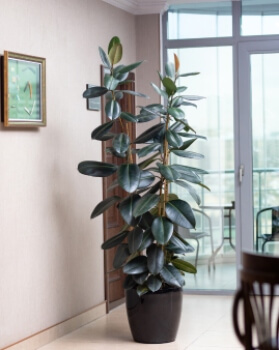
Rubber plants have large, glossy leaves that are thick and rubbery in texture. Ficus elastica are extremely popular indoor plants with big leaves. When grown indoors, in a pot, the plants can be kept to a manageable size. If planted outdoors, they can be unruly and grow 30-40 metres tall.
These plants prefer bright, indirect sunlight. Direct sunlight can scorch the leaves. They grow best in a free draining potting mix. The soil should be allowed to dry out between watering.
Rubber plants are wonderful indoor plants with big leaves. During the growing season, lightly fertilise fortnightly. Do not fertilise during the colder months.
13. Crimson Glory Vine (Vitis coignetiae)
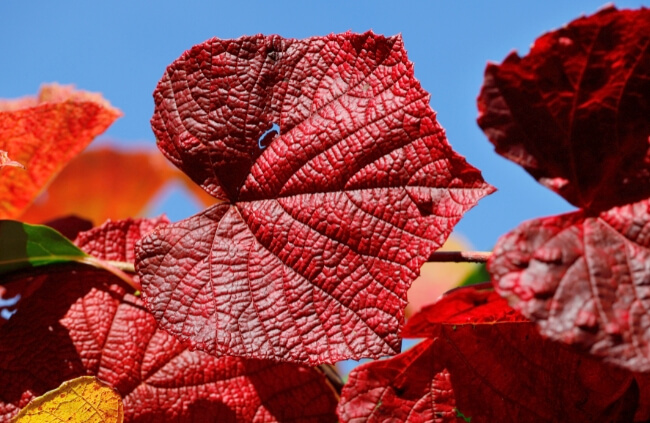
The Crimson Glory Vine is a deciduous climbing vine that can grow up to 15 metres tall by 6 metres wide. The leaves are large and heart shaped. During the spring, the leaves are a reddish-purple colour, in the summer they are deep green.
In early summer, the vine produces very small, greenish-white flowers. In the fall, it produces clusters of inedible black grapes. The Crimson Glory Vine prefers full sun to partial shade. It requires a neutral to low alkaline soil. The plant should be watered regularly.
Use the crimson glory vine outside to cover fences, arbours, trellises, and walls. The vine requires very little fertiliser.
14. Prayer Plant (Calathea)

Prayer plants are popular indoor houseplants with big leaves. The plant features large, oval-shaped leaves. The leaves have intricate patterns that range in colour from deep green to purple to pink. The plant can grow up to 30-60 cm tall, making it a great choice for medium to large spaces.
The Prayer Plant prefers bright, indirect light when grown inside. Outside, they require partial shade. It thrives in well-draining soil. The top of the soil should be allowed to dry in between watering during the warm months.
During the colder months, allow the soil to almost fully dry out. This plant is well-suited for homes and offices. It can be grown indoors or outdoors. Liquid fertiliser should be applied monthly during the warmer months. Reduce feedings during the colder months.
Check out our in-depth guide on Calatheas and find out what are the best varieties to grow in Australia.
15. Dumb Cane (Dieffenbachia)
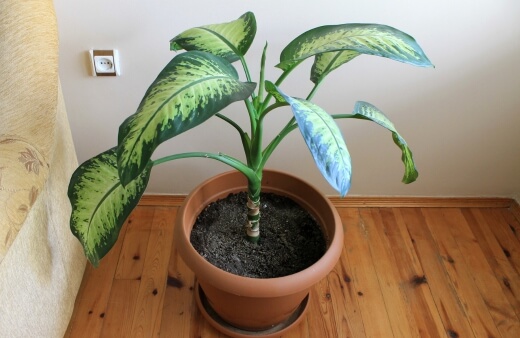
Dumb cane plants are known for their lush foliage and air-purifying qualities. The plant can grow up to 1 metre tall by 1 metre wide. It has large, wide leaves that are usually green with yellow stripes.
These plants need bright, indirect sunlight. Plant them in well-draining, sandy soil. Keep the soil consistently moist but not waterlogged. The Dumb Cane plants with big leaves are typically grown indoors.
It can benefit from occasional fertilisation every 8 weeks from spring to autumn. However, be cautious not to over-fertilise, as this can damage the plant.
16. Black Bat Plant (Tacca chantrieri)
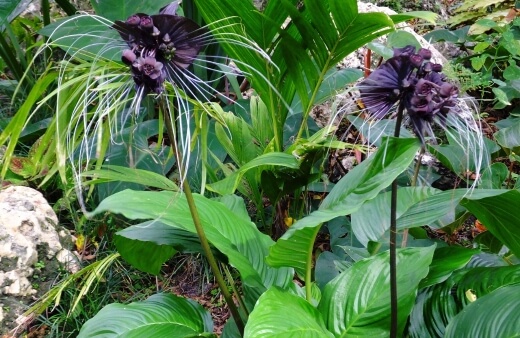
The black bat plant is also known as cat’s whiskers and the devil flower. It is known for its striking black flowers that resemble a bat's face. The plant can grow up to 60-100 cm tall by 60-100 cm wide.
The black bat plant prefers filtered or indirect light. The plant requires well-draining soil that is rich in organic matter. It needs to be watered regularly to keep the soil moist but not waterlogged.
It is typically grown as an indoor plant. Fertilise with a slow-release fertiliser or weekly with a liquid fertiliser suitable for orchids.
17. Rice Paper Plant (Tetrapanax papyrifer)

Rice paper plants are large, fast-growing outdoors plants with big leaves. They can reach up to 4.5 metres in height and spread out 3 metres wide. The leaves are large, deeply lobed, and can grow up to 90 cm wide.
The plant gets its name from its stems, which can be used to make rice paper. These plants can grow in both full sun and partial shade. They prefer well-draining, humus rich soil.
Water frequently and avoid letting the soil dry out completely between watering. The rice paper plant is an outdoor plant. Fertilising with a balanced, slow-release fertiliser once during the spring.
18. Yellow Calla Lilies (Zantedeschia elliottiana)
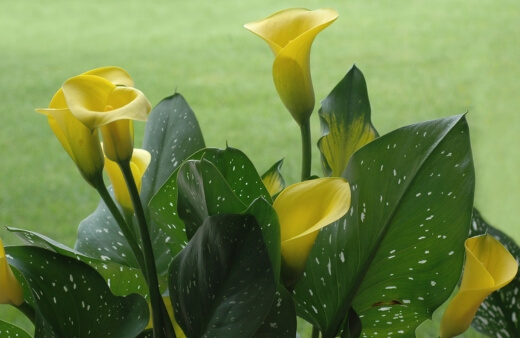
Yellow calla lilies are stunning flowering plants with big leaves. The leaves are arrow-shaped and dark green in colour. They have bright, golden-yellow flowers that grow on long, smooth stems. The flowers are shaped like a funnel or a trumpet and can reach up to 15 cm in length.
The plant itself can grow to a height of 60-90 cm. Yellow calla lilies prefer bright, indirect light. They can tolerate some direct sunlight as long as it is not too intense. They require well-draining soil and regular watering. Avoid overwatering to prevent rot.
Yellow calla lilies are often grown as indoor plants. But they can be grown outdoors in warm, humid climates. When grown indoors, they should be fertilised with a formula formulated for flowering plants.
Fertiliser should be applied every two to three weeks in the spring and summer.
19. Sago Palm (Cycas revoluta)

Sago palm is also known as the Japanese sago palm. It is a slow-growing plant that can reach up to 3 metres tall. Although, it is usually much smaller when grown as a houseplant. The plant has a distinctive look, with feathery fronds that grow in a circular pattern from a central point. The fronds can reach up to 1 metre long.
The sago palm plant prefers bright, indirect light. Too much sunlight can scorch the leaves. It prefers well-draining soil. They require moderate watering with a deep watering bi-weekly.
Sago palms can be grown both indoors and outdoors. Indoor plants can get quite large and be hard to move. Use a blood and bone fertiliser once a year in summer.
20. Fiddle-Leaf Fig (Ficus lyrata)
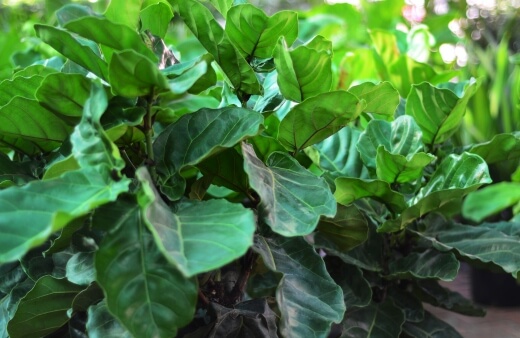
The Fiddle-Leaf Fig (Ficus lyrata) has large, violin-shaped leaves that are dark green and glossy. The leaves have prominent veins that give them a textured appearance. The plant can grow up to 3 metres tall indoors, but it can be pruned to keep it smaller.
The Fiddle-Leaf Fig plant prefers bright, indirect light. It should be planted in well-draining soil. The soil should be left to dry out between watering. Keeping the soil moist will cause root rot. The fiddle-leaf fig is drought tolerant.
The indoor plants with big leaves should be repotted every 2 years. A liquid fertiliser mix should be applied once a month during the spring and summer.
Check out our comprehensive guide to growing Ficus lyrata for more details.
What to Look for When Choosing Plants with Big Leaves
When choosing plants with big leaves, there are a few things to consider.
- Light Requirements: Some plants with big leaves require bright, indirect light, while others can tolerate low light and shade. Select plants that are well-suited to the lighting conditions of your environment to ensure they thrive.
- Plant Watering Needs: Plants have different watering needs. Some plants with big leaves require more frequent watering, while others do better when the soil dries out between watering.
- Size: Take into consideration the size of the mature plant. You want to make sure it fits the space you have for years to come.
- Soil Requirements: Certain plants with big leaves prefer specific soil types. Choose a plant that will work in your soil conditions.
- Maintenance: Some plants require more attention than others. If you do not want to spend much time taking care of your plants, choose one that does not require much maintenance.
- Pets: Do you have pets? Some plants with big leaves are toxic. If you have any pets, avoid plants that can kill them.
- Outdoors or Indoors?Are you looking for outdoor plants with big leaves or indoor plants with big leaves? Some plants can grow in both conditions. However, most grow better either outdoors or indoors.
For more roundup of types of plants, refer to our list below:
Wrapping Up Our List of Plants with Big Leaves to Grow in Australia
Incorporating plants with big leaves into your space can create a peaceful, inviting environment. They not only provide aesthetic appeal, but also offer a range of benefits. With their lush foliage and striking appearance, plants with big leaves are sure to make a bold statement.
Published on May 1, 2023 by Maisie Blevins
Last Updated on September 20, 2025




